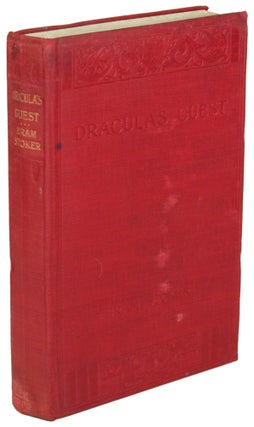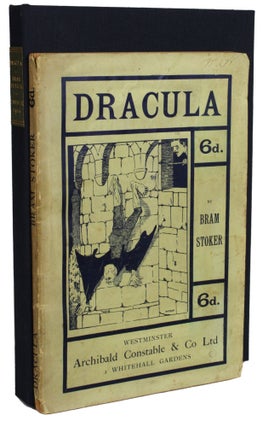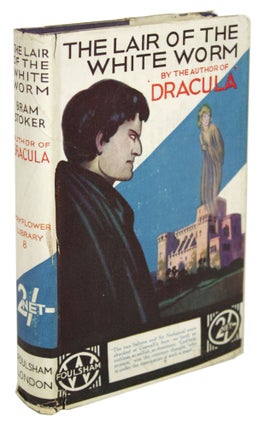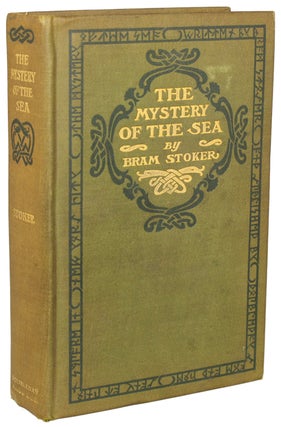Results
THE MAN WHO WROTE DRACULA: A BIOGRAPHY OF BRAM STOKER.
London: Michael Joseph, 1975. Octavo, boards. First edition. Written by Stoker's great nephew.
DRACULA'S GUEST AND OTHER WEIRD STORIES.
London: George Routledge & Sons, Ltd., [1914]. Octavo. pp. [1-8] 1-200, original decorated red cloth, front panel with author, title and decorations stamped in blind, spine panel stamped in gold and blind. First edition, first printing. Posthumous collection of nine stories. "Dracula's Guest" is a previously unpublished episode from an early draft of DRACULA. Barron (ed), Horror Literature 3-187. Bleiler, The Guide to Supernatural Fiction #1551. Dalby 22a.
DRACULA.
Westminster: Archibald Constable and Company, 1901. Octavo, pp. [1-11] 12-138 [139-144: ads], original pictorial gray-green wrappers printed in black. First edition. Most copies of DRACULA take their text from the first edition of 1897 (or the first American edition of 1899, or a 1912 edition that corrected some typographical errors in the first edition). However, in 1901, another significantly different edition appeared, a paperback with a slightly abridged text, revised by Stoker himself at the request of the publisher. Stoker cut about 15% of the text, mainly from descriptions and conversations, in order to make the action scenes stand out a bit more. The paperback edition of 1901 is very rare. Some think this version reads better than the original edition.
THE LAIR OF THE WHITE WORM ...
London: W. Foulsham & Co. Ltd., n.d., [1925]. Octavo, pp. [1-8] 9-190 [191-192: ads], original purple cloth, front and spine panels stamped in gold. Second edition, abridged. This edition was heavily abridged and partly rewritten. "The Freudian, bloodcurdling LAIR OF THE WHITE WORM features a monstrous worm secreted for thousands of years in a bottomless well and able to metamorphose into a woman. It has several parallels to DRACULA (with Sir Nathaniel de Salis assuming the Van Helsing role) and contains some of Stoker's most graphic and grisly moments of horror." - Sullivan (ed), The Penguin Encyclopedia of Horror and the Supernatural, p. 406. Ashley, Who's Who in Horror and Fantasy Fiction, pp. 167-68. Barron (ed), Horror Literature 3-190. Bleiler, The Guide to Supernatural Fiction 1550. Locke, A Spectrum of Fantasy, p. 207. Tymn (ed), Horror Literature 3-236. In 333. Bleiler (1978), p. 187. Reginald 13731. Dalby 21c.
THE MYSTERY OF THE SEA: A NOVEL ...
New York: Doubleday, Page & Co., 1902. Octavo, pp. [i-vi] vii [viii] [1-2] 3-498 [499-500: blank] [note: last leaf is a blank], original decorated olive green cloth, front and spine panels stamped in gold and black, rear panel stamped in black. First edition, first printing. Presentation copy with signed inscription by Stoker dated 22 March 1902, a week prior to publication date (29 March 1902) on front free endpaper: "My dear Elizabeth (Newbery?) / with love & greetings / Bram Stoker / 22.3.02." The Doubleday, Page edition preceded the British Heinemann edition by several months. Ingenious romantic adventure novel "set in Cruden Bay, involving a gun battle at sea, a castle with secret passages, and coded writing based on a cipher described by Francis Bacon." - Dalby, p. 38. "I found the story admirable. It has not the fearsomeness of 'DRACULA' but it is beautifully handled and the girl very admirable indeed ... I've done a bit in cryptograms myself, but that knocks me out!" - Arthur Conan Doyle. Bleiler, The Guide to Supernatural Fiction 1547. Bleiler (1978), p. 187. Reginald 13732. Dalby 13a.




